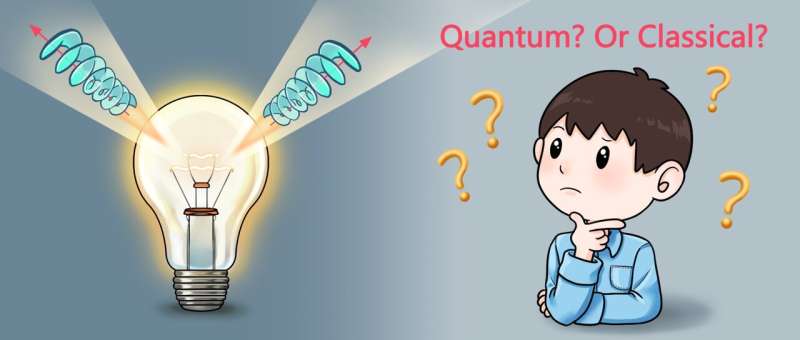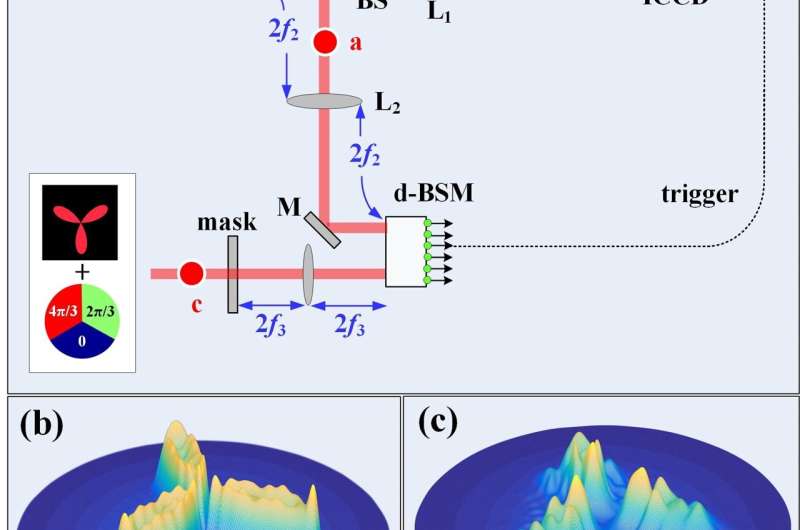Exploring quantum correlations of classical light source for image transmission

There has been an interesting debate on the quantum versus classical origin of ghost imaging in thermal light. To clarify this quantum-classical dilemma, Lixiang Chen at Xiamen University of China formulated a density matrix to fully describe thermal two-photon orbital angular momentum state, which revealed the hidden quantumness with non-zero discord. Then, a scheme of mimicking teleportation was devised to demonstrate the possibility of teleporting an optical image, with an accompanying featureless background.
In science fiction, "teleportation" is commonly portrayed as a means to transfer physical objects from one location to another one some distance away. But in physics, quantum teleportation only transfers quantum information, i.e., the quantum state of a particle, without any physical transmission of the particle itself. The quantum protocol of teleportation was theoretically developed by Bennett and coworkers in 1993 and its first experimental demonstration was realized by Bouwmeester and his colleagues in 1997. Recent progress has been made to realize the teleportation from a transmitter on Earth to a receiver on a satellite, towards a global scale. In the original scheme, quantum entanglement is an essential prerequisite for implementing the teleportation.
On the other hand, ghost imaging represents an intriguing image acquisition technique in which an image can be reconstructed by using a light beam that never interacts with the object. However, it was demonstrated that, besides quantum entangled biphoton source, classical thermal light source can also be exploited for realizing the task of ghost imaging, thus raising a question whether entanglement was truly necessary for ghost imaging. A lot of distinguished work has contributed, both theoretically and experimentally, however the quantum-classical dilemma still persists.
In a new paper published in Light Science & Application, Lixiang Chen from the College of Physical Science and Technology, Xiamen University, China, has investigated this on-going quantum-classical dilemma. In a photon orbital angular momentum (OAM) Hilbert space, he formulated a density matrix to fully describe two-photon state within a thermal light source, which appears as a sum of a high-dimensional OAM entangled state and a diagonal fully separable state. Interestingly, the density matrix is proven to be separable, i.e., zero entanglement per se. Still, this formulation offers a physically intuitive picture to reveal the quantumness hidden in thermal two-photon OAM state, as was characterized by non-zero geometric discord that discerns quantum correlations beyond entanglement.

A following question arises naturally as to whether such non-entangled yet non-classical thermal two-photon state could be explored for any useful quantum applications. The author answered this question positively by revisiting the quantum teleportation protocol. The numerical simulations showed that, at the single-photon level, the thermal two-photon OAM state could be exploited for teleporting a high-dimensional OAM state, in which the retrieved state is just a mixture of an exact replica of the original state and a background maximally mixed one.
Unlike two-dimensional polarization state, the OAM eigenstates form an infinite-dimensional, orthogonal, and complete basis. Therefore, a complex-amplitude optical image can be equivalently represented by a high-dimensional OAM state vector. Thus, the possibility of teleporting a Clover image of both amplitude and phase modulation was also theoretically demonstrated, with multiple repetitions of the protocol.
Professor Chen summarize the operational principle of the protocol like this: "The light field, emitted from a thermal light source, is divided into two paths by a non-polarizing beam splitter, which generates the thermal two-photon OAM state. The photon in one path is directed to interact with another third photon (encoded with the complex-amplitude Clover image) in the high-dimensional Bell state measurement (BSM) stage. Conditional on the BSM results and after being performed with a proper unitary operation, the photon in the other path are sent to hit an ICCD camera working at the trigger mode. Then, the original image can be retrieved correctly by the ICCD camera, with multiple repetition of our protocol."
"In present proposal, the correct transmission of an image is ensured by the pure high-dimensional OAM entanglement component, while the diagonal completely mixed component merely brings about a featureless background." He added.
"In the future, my theoretical framework can also call for further studies of using thermal multi-photon state to demonstrate some new quantum information tasks, such as remote state preparation and novel imaging with undetected photons." Professor Chen forecasts.
More information: Lixiang Chen, Quantum discord of thermal two-photon orbital angular momentum state: mimicking teleportation to transmit an image, Light: Science & Applications (2021). DOI: 10.1038/s41377-021-00585-8
Journal information: Light: Science & Applications
Provided by Chinese Academy of Sciences




















